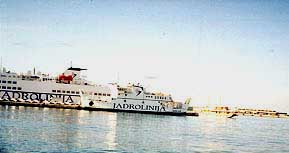Tabor—Just passing through...
Photo by M. King
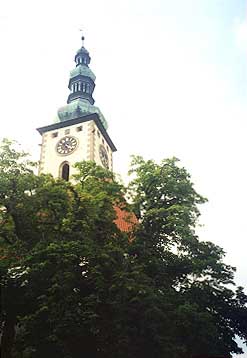
The drive south went through beautiful Czech countryside— rolling hills with many shades of green, towering forests, castles in the distance (yes, must check these out soon), small quaint villages with Baroque churches.
We passed artificial ponds built in the 16th Century—filled with carp. This delicacy is traditionally eaten during Christmas. We picked up more passengers in Tabor. Tabor was inhabited by the Celts in 1st Century B.C. and later founded as a Hussite Town in 1420. Tabor is a National Cultural Monument.
Embark to adventure!—
Photo by M.
King
We embarked on a comfortable passenger ferry to Hvar passing—beautiful islands. At the
ferry terminal near Stari Grad, we were picked up by a bus. The winding road went by
wonderful medieval villages, landscapes with palm trees, fir trees, lavender fields, vineyards,
and olive groves. We arrived at our hotel by the sea—a short walk from Vrboska.
Vrboska!—
Photo by M.
King
Walking along picturesque bays and beaches shaded by large
pine woods, the
water is so clear—it could be a diver's paradise. Vrboska—a 15th Century village,
accentuated by its unique church-fortress in Baroque Renaissance style—is one of the most
beautiful on Hvar Island. Vrboska!—Getting Closer!
Photo by M.
King
Vrboska!—Almost there!
Photo by M.
King
Vrboska!—Arrival!
The hotel served sparse continental breakfasts, and uninspiring dinners—for what was a
low package price. I decided that lunch Vrboska!—Explore!
was to be my main daily meal. I would check out the local
seafood/fish dishes in the various island villages. It proved to be a wise decision, as it was all
quite excellent. Vrboska!—Relax in the shade!
Photo by M. King
Vrboska!—Celebrate victory
over Italy! Vrboska!—Celebrate victory
over Italy!
Vrboska!—Celebrate victory
over Italy!
Vrboska!—Have some wine!
Photo by M.
King
Hvar—Marina
Photo by M.
King
The local bus from Vrboska to the town of Hvar cost 19kn. The
bus stops near an open air market, where you walk through to the magnificent Piazza. This
beautiful square is lined with shops and restaurants. Dominated by St. Stephen's Cathedral, it
is bordered by the palaces of Groda and the cascading stone-built houses of Burag.
Hvar—Hvar
Photo by M.
King
Walking along the waterfront promenade, you see a row of palm
trees and
seven–centuries–old walls. Topped by the fortress protecting Hvar, they extend downwards to
the town. Hvar immediately presents itself as a monument—a jewel hidden by time. Hvar—Marina
Photo by M.
King
Its harbor spreads towards the sea and you see small islands
called Pakleni
Otoci. You walk past hotels, apartments, restaurants and cafes, all reflecting the glossy spirit
of an exquisite resort area for almost a century and a half. The smell of lavender is in the air. I
checked out the Amfora Hotel and their dive operation. I had an Octopus Salad for lunch
accompanied by a glass of cold white wine. Yes—definitely must return. Hvar—Hike up to the
fortress Photo by M.
King
Hvar—The fortress
grounds... Photo by M.
King
Hvar—Fortress...Whatta
view!
The Fortica Hvar is perched on a hill above the old town and encloses the city's walls. The
original fortress was built circa 1150. When the Turks invaded Hvar circa 1570, all the
villagers were saved by hiding there. In 1579 it was restored after a gun-powder explosion
caused considerable damage. During French rule additional reinforcement was done. Barracks
and observation post were built during Austrian rule. Today, the fortress has been
reconstructed as a modern tourist complex with diverse facilities. Once used exclusively as a
fortified position, the fortress has become a landmark. It commands a superb view of the
town and its surroundings—especially by night when the floodlit stone forms of the ancient
town appear against the dark skies. Stari Grad—Harbor
Photo by M.
King
Missing the bus to Jelsa one sunny morning, I opted for the next
bus which went to Stari Grad. The bus ride was 10kn. Stari Grad, one of the oldest
settlements on the Hvar coast, was founded by the Greeks in 4th Century BC and named
Pharos. Today you see signs in town saying both Pharos and Stari Grad.
Pharos is buried under present day Stari Grad. Architectural remains indicate its original
lay-out—such as parts of 11-metre long Greek Walls—the Cyclopean Stari Grad—Typical Street
Photo by M.
King
A Roman town grew up around the perimeter of the Greek town and two preserved Roman
mosaics remain under the pavement in the present-day Sridnja ulica (Middle Street). There
was a Roman bath under the church of Sv. Roko. A medieval settlement grew up north of the
Greek town and also on the eastern coast.
However, these early settlements do not greatly affect the architecture of Stari Grad. The
majority of existing buildings were built during the 16th–17th Centuries in Renaissance and
Baroque style. But, many buildings with Romanesque and Gothic traces are visible. Stari Grad—Enjoy some
wine! Photo by M. King
The Hvarske Vinarije is walking distance from the center of Stari
Grad's lovely harbor. It was siesta time when I arrived. I just logged my fourth delicious
seafood salad lunch. A worker at the winery suggested I walk a short distance to a little
home-based winery. After tasting, I bought some of their home-made wares—which included
lavender oil and olive oil. In addition to selling home-made wines, herbal liquors, lavender,
and olive oil—this lovely couple also rents out part of their home to guests.
Waiting for the bus to Vrboska, I struck up a conversation with an English lady who was
driving in my direction—and so returned by car. She has lived on Hvar for 20 years, married to
a fisherman. She wouldn't change her lifestyle for anything! Their two children speak 3
languages—English, and two Croatian dialects—the island dialect and the mainland dialect. I
guess they are quite different. She also mentioned that the kuna has become very strong in its
appreciation against the British pound—interesting! Jelsa—Toward evening...
Photo by M.
King
Jelsa is situated in the middle of the north coast of Hvar Island. Its population is concentrated
on the sea—and the outskirts are surrounded by dense pine woods on sloping hills. The only
place on Hvar with an abundance of fresh water, Jelsa has lusher vegetation. Entering Jelsa by
road, you pass through an alley of poplars that leads into the town park. The lush vegetation,
is surprising and very rare in this distinctly stony area.
At first sight Jelsa seems to be a relatively new town with 19th Century characteristics in its
architecture. Its interesting shape touches upon the churches of St. Fabian and Sebastian, and
then branches off into small streets, with a small square where you find the small church of
St. John.
You see much new construction. However, you gradually discover while walking around,
Jelsa is an old town with a history dating back to ancient times. Like Stari Grad, Jelsa was
settled by both Greeks and Romans.
Tightly packed around the picturesque square, which reaches the waterfront, you find many
restaurants and cafes specializing in ice cream concoctions. People come from all over Hvar
Island to Jelsa to have ice cream. My coffee ice cream concoction cost 20kn (under
US$2)—filled an ample size dish and was yummy. Harbor—On way home...
Photo by M.
King
The Jadrolinija car ferry from Stari Grad to Split is the largest
ferry I have ever been on.
Besides, cars, motorcycles, bicycles, and passengers—there were at least 20 large tour
buses—some capable of holding more than 100 people. The fare for the 2 hour crossing was
27kn—or approximately US$2.50. There were a number of cafes that served wine, beer, coffee
and snacks as well as the restaurant Pharos—completely set up for fine dining, but serving
sandwiches and french fries. What a waste!!
It was time to relax before the long bus ride back to Prague. The 1998 Platski Plavac from
Korcularsko Vinogorije was oak cured with hints of spice and delicious. Zhivjeli!
It's easy to consider moving to Hvar—an apartment, a villa, a farmhouse, perhaps a boat. It
must be a wonderful place to spend a Prague winter. I will return and find out more!!!
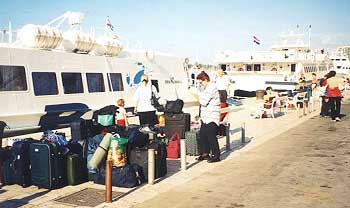
Our bus arrived the next morning in Split—warm sunshine, brilliant blue skies,
clear
turquoise water. A very nice mixture of old and new—so much life! Croatian folk music
emanating from cafes and restaurants across from the busy harbor. Ferries large and small
passing each other. A huge, bustling outdoor market encompassing many city blocks. Lots of
new construction. What was once open hillside is now covered with new homes. Split has
grown so much since my last visit!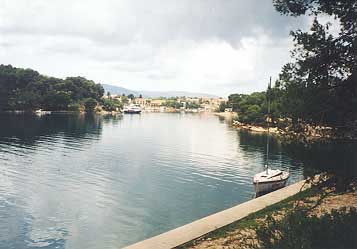
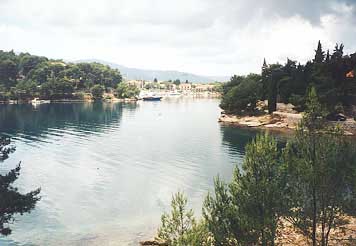
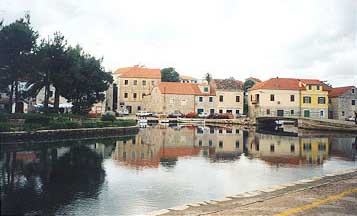
Photo by M.
King
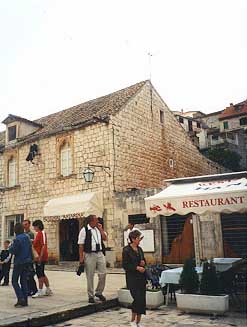
Stopping for lunch at the Buffet Skojic', Vrboska, I had my first of numerous
seafood salad
lunches. The Salad Frotti DeMare consisted of mussels, shrimp, clams, squid, octopus, local
fish with chunks of garlic, olives, and marinated in olive oil and served on a heaping bed of
lettuce. It filled a normal dinner plate. The local Hvar red wine was dry with hints of fruit and
spice—but the bottle has a screw cap like a soda bottle instead of a cork. Surprisingly, this did
not have a reflection on the taste. The cost was under US$4 for salad,
bread, and two glasses of wine.
Photo by M.
King
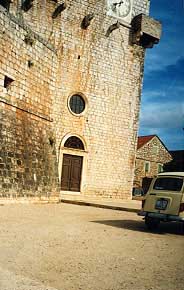
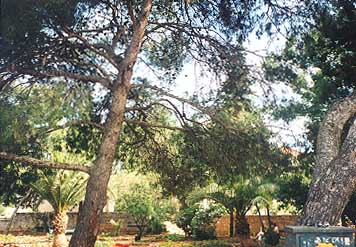
Photo by M.
King
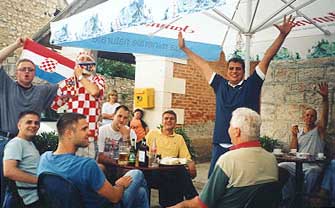
Croatian folk music coming from the restaurant next door—families
joined together in celebration. They sang with the music, cheered, danced, drank and dined.
The Croatian flag was proudly on display. Passing by, they invited me to join them! I was
warmly welcomed into their festivities. Saturday, June 8—Croatia won the Football Game
over Italy!! Vrboska was alive!!
Photo by M. King
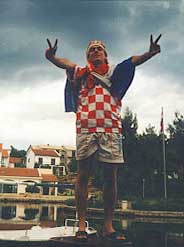
Photo by M.
King
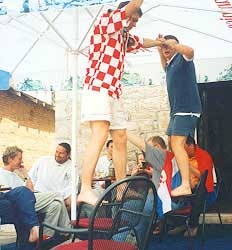
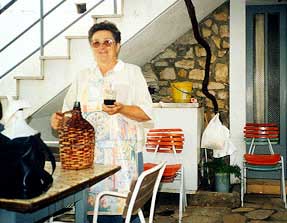
On my walk back to the hotel, I stopped at a home-based winery. They offered
red or white
wine in a glass or plastic bottle. I tasted!—opting for red in a glass bottle. Cost was 10kn,
which was under US$1.
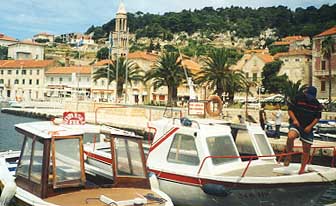
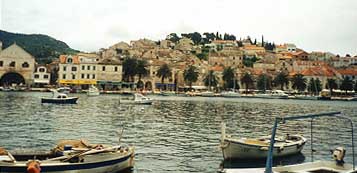
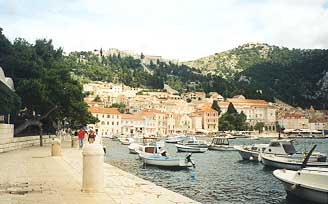
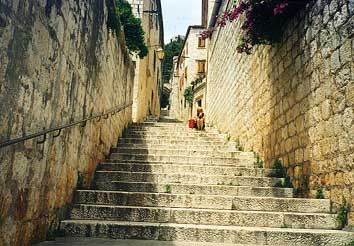
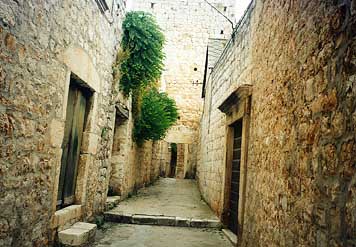
Photo by M. King
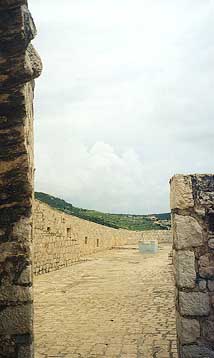
It looks like an impossible climb. The Fortica Hvar (town fortress) is reached
by following
the road behind the town, or by directly climbing one of the several sets of steps to the road.
You enter through a gateway from the road, then hike up a winding path through gardens
planted with trees and cactus. How ever you approach—it is well worth it—for the stunning
views and remarkable state of preservation. Admission is 10kn, paid when you are almost to
the top. Keep your ticket and use it again when you return.
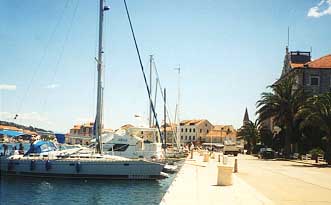
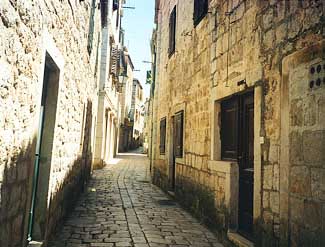
Walls in the Tadic-Gramatorovi wine cellar. These walls compose part of the
north city wall.
The east walls are just visible behind the church of Sv. Ivan (St. John). Stone blocks from the
city walls were incorporated into the foundations of the bell tower—Stari Grad's main
entrance.
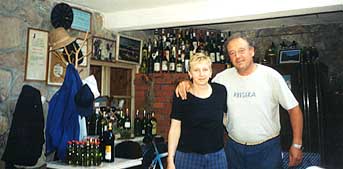
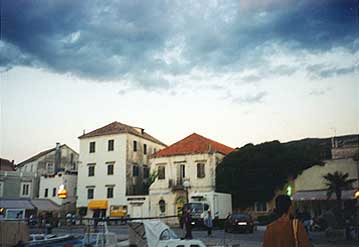
The evening boat ride on the Andrija to Jelsa took about 10 minutes.
The sea was
calm and still. The sky was aglow with the colors of sunset.
